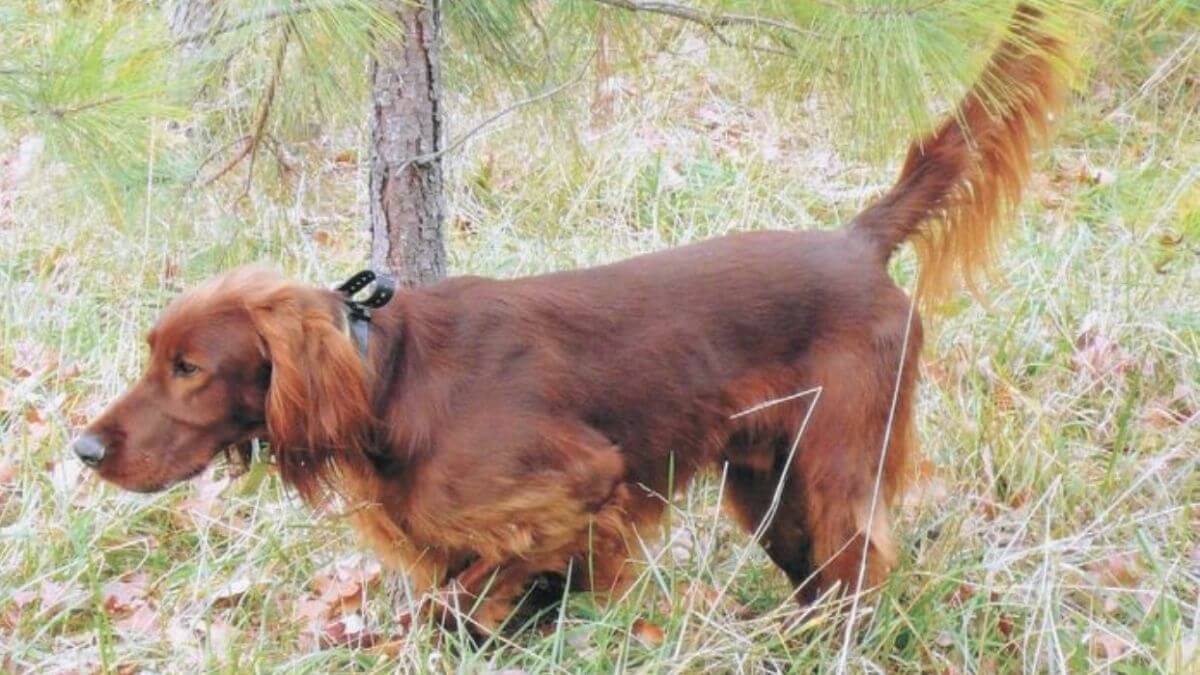
Home » The Irish Setter From Then…Until Now!

This article was originally published in Showsight Magazine, August 2014 issue.
Going back as far as records and stories allow, it is commonly thought that the Irish Setter today, started as a mix of European spaniel, most likely Spanish, some Irish Water Spaniel, and perhaps a Pointer. It is felt that the spaniel most likely arrived in Ireland via the Spanish Armada and that the inhabitants of Ireland added the Irish Water Spaniel and Pointer into the mix, producing a versatile hunting dog whose form would work well over the soft bog-like terrain of Ireland.
The Irish Setter developed into a single breed in the early 1800s, and by somewhere around 1850 was seen regularly in the families of Irish aristocracy who were busily developing their own lines. The breed was both solid red, and in the same whelping box, red and white. Over time the solid mahogany became preferred; solids red pups were kept and bred to other solid specimens. The red and white was not the dog of choice in these times and those in existence were sent to the kitchen or stables to work. With this culling for color, the Irish Red and White became almost extinct until their resurrection in the mid 1950s. But the dark red Irish Setter thrived.
In 1870, a dog came on the scene in Ireland that solidified the make and fit of the breed. This dog was Ch. Palmerston. While his exact date of birth is not known, we can track his ownership back to Cecil Moore, one of the founders of the Irish Setter Club in Dublin. Moore later sold Palmerston to J. M. Hilliard who proudly showed him in London in 1875. From here records are clear; show records prove Palmerston was a sensation in London, dark in color, with a small patch of white on his muzzle that later became known as the Palmerston snip. On occasion today we still see evidence of that snip, and some allowable white elsewhere, too.
Palmerston was used at stud in England, and while his feet never touched U.S. shores, sons and daughters arrived in America at the homes of serious breeders and hunters. One of the most influential breedings was that of Rose, a Palmerston daughter imported by Dr. William Jarvis in 1877, bred to Elcho, an Irish import. Elcho became the first American bench champion, with an impressive show career that included appearances in the ring at Chicago, St. Louis, New York and Boston. His mating with Rose set the look in America for the Irish, in both the show ring and the field. In 1878 the Irish Setter standard was accepted by the AKC, and the breed was on its way. The first AKC registered Irish, was Admiral 534 and registrations grew in abundance as this beautiful breed took hold.
The breed remained popular in the show ring, but was equally admired in the field. Developed to retrieve upland game, the breed originally “set” (crouched) on the bird, and the hunter came and threw a net over both dog and game. Today, this versatile hunter is popular in field trial events and hunting tests and happily awaits the gun shot and to be sent for the retrieve.
Fast forward to the mid 1970s. The Irish Setter consistently ranked in the top 5 most popular AKC breeds, spurred on by the movie Big Red and the presence of the breed in the Nixon White House. Over 70,000 were registered in just a few years. The breed suffered in form and function, families who coveted their dog as a puppy, did not know how to handle the rollicking personality of the breed, nor deal with its need for exercise. People were one-time or backyard breeders with little to no experience of their own and new puppy owners had no one to rely on. The breed suffered greatly, and it took a good deal of work by serious breeders to bring the Irish back to its current status, that of a wonderfully rollicking, loyal family dog. Where we once ranked high up in popularity we now are in about 74th place with registrations annually somewhere between 1,200 to 1,500.
The Irish Setter is the ultimate show dog, but their versatility and spirit make them happy to participate in any challenge. They are commonly seen holding the blue ribbon in Obedience, Agility and Rally. They are known to be splendid dock divers and can catch a frisbee with the best of them. They are frequently the choice of junior handlers competing at the highest levels. The breed’s work in the field has not suffered, as can be evidenced by an annual trip to Booneville, Arkansas for the national field trial championship. The dual dog is re-emerging, and during the past 5 years through the work of a select group of breeders the breed has added many more duals to its ranks. In the hunting test venue, at last count 45+ Irish held Master Hunter titles.
Like everything in life, you can’t be all things to all people. The Irish Setter is not for everyone; he is slow to mature, both physically and mentally, and has a very high energy level.
This combination can be a challenge to live with at times. At 2 years of age a light bulb goes on somewhere and he usually becomes the dog of your dreams. He requires regular exercise and there is the need for consistent though not difficult grooming. When I receive puppy inquiries, my first question is always, “Have you owned an Irish before?” Those that have, go to the top of the list.
Through the approximate 200 years of history, the Irish Setter has endured fads and fashion, over population and movie stardom. Gratefully the breed as we see it now is in excellent hands and the Irish Setter has returned to its origins, that of an athletic, aristocratic bird dog. Today, this breed is happy circling a group ring, on point in a field or just “flopped down on the hearth.” What could be better than that?
The Irish Setter is the ultimate show dog, but their versatility and spirit make them happy to participate in any challenge. They are commonly seen holding the blue ribbon in Obedience, Agility and Rally.
